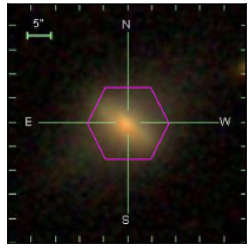Luminous AGN
Contact

| Jenny Greene |
|---|
| Princeton University |
Summary
We aim to increase the dynamic range in AGN luminosity in the MaNGA sample by adding rare but luminous active galaxies. In order to mitigate bias, we select these targets based on hard X-ray emission (using the SWIFT/BAT candidates), and [OIII] emission (using the SDSS main sample and work by Mullaney et al. 2013) and WISE colors (Wright et al. 2010).
Finding Targets
An object whose MANGA_TARGET3 or MNGTARG3 value includes one or more of the bitmasks in the following table was targeted for spectroscopy as part of this ancillary target program. See SDSS bitmasks to learn how to use these values to identify objects in this ancillary target program.
| Program (bit name) | Bit number | Target Description | Target Density (deg-2) |
|---|---|---|---|
| AGN_BAT | 1 | BAT AGN in the DR7 footprint | low |
| AGN_OIII | 2 | [OIII]-selected AGN matched to BAT luminosities | low |
| AGN_WISE | 3 | [OIII]-selected AGN matched to BAT luminosities | low |
| AGN_PALOMAR | 4 | AGN from the Palomar survey in the DR7 footprint | low |
Description
The primary goal of this program is to increase the dynamic range in AGN luminosity covered by MaNGA. Since we are interested in both the extent of the narrow-line region and the host stellar populations, we focus specifically on Type 2 or narrow-line AGN. To mitigate various selection biases, we select samples selected from hard X-ray, optical line emission (specifically the strong and ubiquitous [OIII]5007 line) and MIR using WISE.
We start with the SWIFT/BAT sample of AGN, and take all ~20 objects in the DR7 footprint. This small sample is nevertheless important because hard X-ray selection is least biased by obscuration or orientation. We select matched samples using [OIII] or WISE selection (see below).
We are interested in studying both the hosts of these luminous AGN (e.g., the stellar populations and structures of the host galaxies as compared to matched inactive samples) and the spatial extent and kinematics of the narrow emission lines. We hope to gain new insights into fueling and feedback mechanisms by studying narrow line regions on galaxy-wide scales over a wide range in luminosity.
Therefore, bundle sizes are selected to include both the extent of the host galaxy and the expected extent of the narrow line region, whichever is larger.
Target Selection
We start with the SWIFT/BAT sample of AGN, and take all ~20 objects in the DR7 footprint. This small sample is nevertheless important because hard X-ray selection is least biased by obscuration or orientation.
We then take the [OIII]-selected catalog of Mullaney et al. (2013) to select our second sample. We would like the distribution of bolometric luminosities to match across all subsamples. We start with objects having >10 sigma line detections in all four strong lines (Hβ, [OIII], Hα, [NII]) to be sure that the reddening corrections are robust. We then use the Balmer decrement to derive a corrected [OIII] luminosity for each source.
We match the [OIII] sample to the BAT sample by selecting 5 [OIII] objects at comparable Lbol to each BAT object, within a redshift range of 0.01-0.08. For the [OIII] sources, we use a bolometric correction of 600 applied to reddening corrected [OIII] (Shao et al. 2013), while for the BAT we apply a bolometric correction of 5 (Vasudevan & Fabian 2009).
We then select WISE targets using a WISE color-selected sample in the color space 0.7 < W1-W2 < 2.0 and 2.0 < W2-W3 < 4.5 (following the prescriptions of Wright et al. 2010). To minimize contamination from luminous star-forming galaxies we apply a WISE luminosity cut of Lbol > 1043 erg/s, using a bolometric correction of 6 (Richards et al. 2006). Again we select up to 5 matches for each BAT target over 0.1 < z < 0.8 .
Finally, we ensure that each target AGN has at least 2 inactive galaxies that match in redshift, stellar mass, and size. Roughly 10 percent of the galaxies need controls to be observed for them.
Our goal is to observe 85 AGN and 15 control galaxies.
REFERENCES
Mullaney, J.R., Alexander, D.M., Fine, S., et al., 2013, MNRAS, 433, 622
Richards, G.T., Lacy, M., Storrie-Lombardi, L.J., et al. 2006, ApJS, 166, 470
Shao, L., Kauffmann, G., Li, C. et al., 2013, MNRAS, 436, 3451
Vasudevan, R.V., Mushotzky, R.F., Winter, L.M. & Fabian, A.C., 2009, MNRAS, 399, 1553
Wright, E.L., Eisenhardt, P.R.M., Mainzer, A.K., et al., 2010, AJ, 140, 1868


